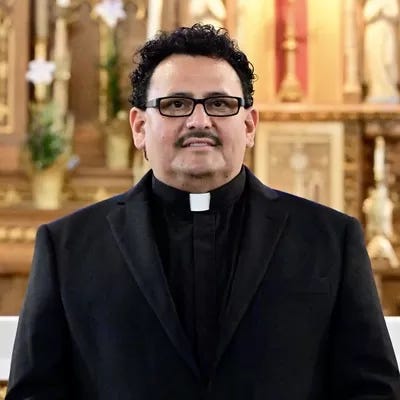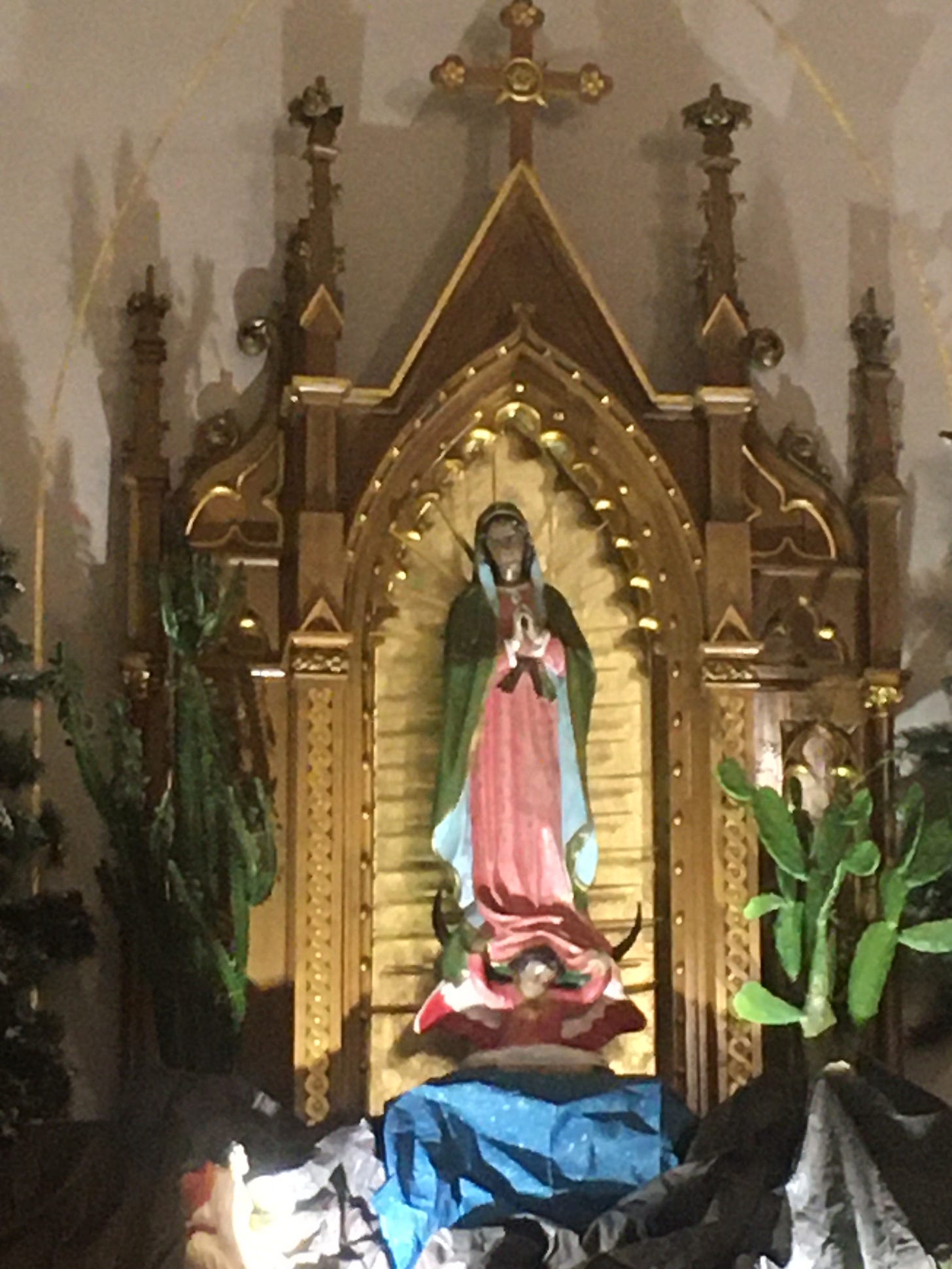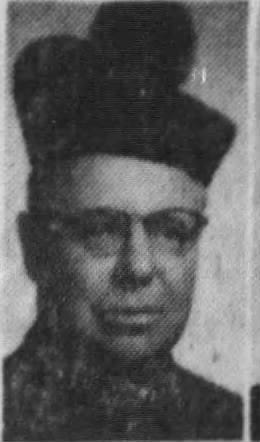Waterloo parish stands with immigrants
Queen of Peace carries on service tradition of forerunner parish, pastor

WATERLOO — I miss Sunday mornings with my dad.
For about 15 or 20 years after I graduated from high school, I’d head over to his house on the east side of town for a hearty breakfast and church.
Buckwheat pancakes, sausage and coffee strong enough to burn a hole through the kitchen table were the order of the day. Leo Greco’s “Variety Time” show out of WMT in Cedar Rapids was on the radio.
That was followed by Sunday Mass at St. Joseph’s Catholic Church, Waterloo’s “mother church.” The parish was established in 1863 and the current church building was built in 1900-01. It’s now Queen of Peace Parish and also home to Waterloo’s Hispanic Catholic ministry, but a lot of us old timers still refer to it as “St. Joe’s.”
“I like to go to St. Joe’s,” Dad would say. “You never know when Brady is going to pull off a good one.”
He was referring to the Right Rev. Msgr. Duane A. Brady, the pastor. Dad got a kick out of the baritone-voiced Brady’s droll Irish wit, sure to come out on a Sunday close to St. Patrick’s Day.
But Brady also was known as a force for justice and disadvantaged people in Waterloo.
Brady helped establish the Park Towers ecumenical low-income elderly housing project in downtown Waterloo in 1970, led the fund drive to build Waterloo Columbus High School in 1959, as well as St. Francis Hospital, now MercyOne Waterloo, in the mid-1960s. He and parish staff also gave away food at the parish rectory and the parish school, Our Lady of Victory Academy, had a racially integrated student body.
A Belmond native, Brady served as a U.S. Navy chaplain during World War II, taught at the American College in Rome from 1945-48 and worked in the Displaced Persons office at the Vatican from 1948-49 under Cardinal Giovanni Montini, who later became Pope Paul VI.
Monsignor Brady passed away in 1987 but the church continued its mission of serving the needy in Waterloo after it became Queen of Peace following the consolidation of four parishes in east Waterloo and Evansdale. It became home to Waterloo’s Hispanic ministry, under the leadership of Sister Kathleen Grace, concurrent with an influx of residents of Latino residents after the IBP/Tyson meatpacking plant opened in 1990.
In 2014, Queen of Peace’s Latino parishioners pitched in and helped with a $350,000 renovation and restoration of the present church building, built in 1900. The mosaic flooring of the church, carpeted over in the 1960s, was completely restored after the carpeting was taken up as well as wood flooring under the pews. The church has hosted Spanish-language and bilingual services for more than 30 years in addition to English.
So it was logical that with recent heightened concerns and awareness over immigration issues and potential mass deportations and separations within families, that some kind of religious service would be held at the church.
A bilingual “Pentential Rosary for Immigrants” began Tuesday, Dec. 3 and is being held nightly through Dec. 11, prior to the Dec. 12 religious feast day of Our Lady of Guadalupe, patroness of the Americas and its indigenous people. It marks the appearance of Mary, the mother of Jesus Christ, to the peasant St. Juan Diego at Guadalupe, Mexico in 1531.
The nightly rosary, a series of prayers for the intercession of Mary on behalf of the faithful, was the idea of the Rev. Nils de Jesus Hernandez, the current pastor.
“We are beginning the ‘perfect storm,’ ” he said, and asking for the intercession of Our Lady of Guadalupe for strength and support “as we are entering into this perfect storm,”

Father Hernandez, who holds a doctoral degree in ministry, is a native of Nicaragua. He came to the United States as a young college student in November 1988 to escape the repression of Nicaraguan President Daniel Otega’s Sandinista regime.
He made the journey over land and crossed over into the United States on a makeshift raft with others over the Rio Grande River. Not everyone who made similar journeys survived. Some drowned when the wide river was deep and swift after rain.
He studied for the priesthood in Los Angeles where he had family, completed those studies at Divine Word Seminary in Epworth and was ordained a priest in the Roman Catholic Archdiocese of Dubuque in 2004.
He was an associate pastor and director of Hispanic ministry and liturgy at Queen of Peace early in his priesthood, from 2005-08 and various assignments in between around northeast Iowa before returning as pastor in 2020. So he holds a special affection for the parish.
He has also been active on immigration issues locally and at the state level. The immigration system is broken, he said, and needs reform, with no significant congressional legislation since the mid-1980s. There are good and bad individuals in any population, he said, but he emphasized the importance of keeping families together.
“What we are doing here is perhaps nothing in the eyes of many,” Hernandez said of the nine days of prayer. “But what we are doing is the spiritual aspect. We are begging the Lord to be with us and to be with people that will be devastated by these family divisions that will be created by this perfect storm.”
The nightly services were announced separate from, but concurrent with, the issuance of a “letter of solidarity” with immigrants issued by Iowa’s four Roman Catholic bishops, each of which preside over a different regional diocese of the state.
According to the Data Center of Iowa, there are more than 215,000 Latino residents in Iowa, about 6 percent of the state’s population. The Latino population in Iowa increased 46 percent from 2000 to 2020.
Immigrants make up 6 percent of the state’s population, about 189,000, according to USAFacts.org, based on census data. According to American Immigration Council data through 2018, three fifths was naturalized or eligible for naturalization. But that would leave potentially tens of thousands who are not.
I attended the first night’s rosary at Queen of Peace. I sat in the pew Dad and I used to sit in, in the narrow pews on the left side of the church that Dad used to jokingly refer to as “bachelor’s row.” The statue of Mary, Our Lady of Guadalupe, is at the front of that side of the church.

Below and in front of the statue of Our Lady of Guadalupe was a diorama of a family under a Mexican flag standing on their side of a river, looking for an opportunity to cross. Father Hernandez said he had the diorama made based on his and others’ experiences and it sits at the foot of the statue to symbolize Mary watching over those families.
As the prayers were said, I was thinking of the immigrant families - but also instinctively aware I was sitting at a spot my dad and I had sat years ago. I was aware of a twinge of emptiness at his absence and tried to relate that to the longing and hope some families may feel that they will be able to stay together.
I will never forget the grip of my father’s hand — a strong, powerful, thick-fingered workingman’s grip, a grip he maintained until the day he died. It was a grip of support, strength and security. It was as strong as my mother’s was gentle, equally supportive and secure.
Those present prayed that every child will know and feel that kind of security so that they can grow and thrive — a prayer born out of the conviction that every child, of any land or tongue deserves a chance to love, be loved and to grow, thrive and pass it on.
Monsignor Brady knew that and demonstrated it by his works of mercy with displaced persons after World War II and with disadvantaged persons in Waterloo — as do the faithful at his old church today.
”It goes back to the Gospel of Matthew: If you did it to others, you did it unto me,” Father Hernandez said. “I do not want to go hell because I did not do what I was supposed to do.”
The prayers at Queen of Peace continue in person and livestreamed 7 p.m. nightly through Wednesday, Dec. 11. The Feast of Our Lady of Guadalupe is Thursday, Dec.12.
Pat Kinney is a freelance writer and former longtime news staffer with the Waterloo-Cedar Falls Courier and, prior to that, several years at the Ames Tribune. He is currently an oral historian with the Grout Museum District in Waterloo. His “View from the Cedar Valley” column is part of “Iowa Writers Collaborative,” a collection of news and opinion writers from around the state who previously and currently work with a host of Iowa newspapers, news organizations and other publications. They are listed below. Clink on the links to check them out, subscribe for free - and, if you believe in the value of quality journalism, support this column and/or any of theirs with a paid subscription .
The Iowa Writers’ Collaborative






👍A wonderful “bit” of Iowa/Waterloo history.
Regardless of the theological reasoning, the facts remain, these are people who work and support themselves at whatever they can do, we should welcome them as members of our state and country the same as any other immigrant that legally makes their way here. Escaping from their homes to come here because of threats of murder and persecution, (much of which were created by us in the Contra "wars" and Reagan's illegal CIA wars in Central America) should be allowed into the country, especially if they have family already here. They are the people rural America need to fill up their small towns with active local businesses and keep our schools alive and well!